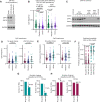The antiviral state has shaped the CpG composition of the vertebrate interferome to avoid self-targeting
- PMID: 34491982
- PMCID: PMC8423302
- DOI: 10.1371/journal.pbio.3001352
The antiviral state has shaped the CpG composition of the vertebrate interferome to avoid self-targeting
Abstract
Antiviral defenses can sense viral RNAs and mediate their destruction. This presents a challenge for host cells since they must destroy viral RNAs while sparing the host mRNAs that encode antiviral effectors. Here, we show that highly upregulated interferon-stimulated genes (ISGs), which encode antiviral proteins, have distinctive nucleotide compositions. We propose that self-targeting by antiviral effectors has selected for ISG transcripts that occupy a less self-targeted sequence space. Following interferon (IFN) stimulation, the CpG-targeting antiviral effector zinc-finger antiviral protein (ZAP) reduces the mRNA abundance of multiple host transcripts, providing a mechanistic explanation for the repression of many (but not all) interferon-repressed genes (IRGs). Notably, IRGs tend to be relatively CpG rich. In contrast, highly upregulated ISGs tend to be strongly CpG suppressed. Thus, ZAP is an example of an effector that has not only selected compositional biases in viral genomes but also appears to have notably shaped the composition of host transcripts in the vertebrate interferome.
Conflict of interest statement
The authors have declared that no competing interests exist.
Figures





Comment in
-
Less is more: Biased loss of CpG dinucleotides strengthens antiviral immunity.PLoS Biol. 2021 Sep 8;19(9):e3001353. doi: 10.1371/journal.pbio.3001353. eCollection 2021 Sep. PLoS Biol. 2021. PMID: 34495970 Free PMC article.
Similar articles
-
Does the Zinc Finger Antiviral Protein (ZAP) Shape the Evolution of Herpesvirus Genomes?Viruses. 2021 Sep 17;13(9):1857. doi: 10.3390/v13091857. Viruses. 2021. PMID: 34578438 Free PMC article. Review.
-
CpG Dinucleotides Inhibit HIV-1 Replication through Zinc Finger Antiviral Protein (ZAP)-Dependent and -Independent Mechanisms.J Virol. 2020 Feb 28;94(6):e01337-19. doi: 10.1128/JVI.01337-19. Print 2020 Feb 28. J Virol. 2020. PMID: 31748389 Free PMC article.
-
Comparison of CpG- and UpA-mediated restriction of RNA virus replication in mammalian and avian cells and investigation of potential ZAP-mediated shaping of host transcriptome compositions.RNA. 2022 Aug;28(8):1089-1109. doi: 10.1261/rna.079102.122. Epub 2022 Jun 8. RNA. 2022. PMID: 35675984 Free PMC article.
-
The dinucleotide composition of the Zika virus genome is shaped by conflicting evolutionary pressures in mammalian hosts and mosquito vectors.PLoS Biol. 2021 Apr 19;19(4):e3001201. doi: 10.1371/journal.pbio.3001201. eCollection 2021 Apr. PLoS Biol. 2021. PMID: 33872300 Free PMC article.
-
All About the RNA: Interferon-Stimulated Genes That Interfere With Viral RNA Processes.Front Immunol. 2020 Dec 9;11:605024. doi: 10.3389/fimmu.2020.605024. eCollection 2020. Front Immunol. 2020. PMID: 33362792 Free PMC article. Review.
Cited by
-
Less is more: Biased loss of CpG dinucleotides strengthens antiviral immunity.PLoS Biol. 2021 Sep 8;19(9):e3001353. doi: 10.1371/journal.pbio.3001353. eCollection 2021 Sep. PLoS Biol. 2021. PMID: 34495970 Free PMC article.
-
Omics Analyses Uncover Host Networks Defining Virus-Permissive and -Hostile Cellular States.Mol Cell Proteomics. 2025 May;24(5):100966. doi: 10.1016/j.mcpro.2025.100966. Epub 2025 Apr 7. Mol Cell Proteomics. 2025. PMID: 40204275 Free PMC article.
-
Association of ZC3HAV1 single nucleotide polymorphisms with the susceptibility of Vogt-Koyanagi-Harada Disease.BMC Med Genomics. 2023 May 23;16(1):113. doi: 10.1186/s12920-023-01546-3. BMC Med Genomics. 2023. PMID: 37221558 Free PMC article.
-
Defining the characteristics of interferon-alpha-stimulated human genes: insight from expression data and machine learning.Gigascience. 2022 Nov 18;11:giac103. doi: 10.1093/gigascience/giac103. Gigascience. 2022. PMID: 36399061 Free PMC article.
-
Endogenous ZAP is associated with altered Zika virus infection phenotype.Virol J. 2024 Nov 9;21(1):285. doi: 10.1186/s12985-024-02557-x. Virol J. 2024. PMID: 39522048 Free PMC article.
References
-
- Shaw AE, Hughes J, Gu Q, Behdenna A, Singer JB, Dennis T, et al.. Fundamental properties of the mammalian innate immune system revealed by multispecies comparison of type I interferon responses. PLoS Biol. 2017;15(12). ARTN e2004086.10.1371/journal.pbio.2004086. WOS:000418943900021. doi: 10.1371/journal.pbio.2004086 - DOI - PMC - PubMed
Publication types
MeSH terms
Substances
Grants and funding
LinkOut - more resources
Full Text Sources

